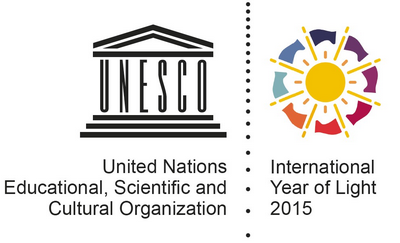
Hawaiian, Oceanic and Global Cultural Astronomy: Tangible and Intangible Heritage
A meeting held at Hilo, Big Island of Hawai‘i, August 16–20, 2015
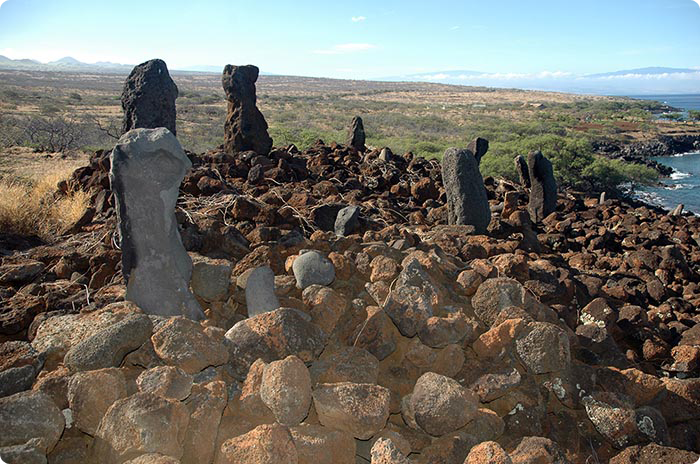
Holo Moana, a sacred navigation temple on the coast of the Big Island of Hawai‘i. Photograph © Clive Ruggles
This five-day meeting, organised by the IAU Working Group on Archaeoastronomy and Astronomy in Culture together with the Center for Astronomy and Physics Education Research, had a number of aims:
- To bring together people with direct knowledge of and/or interest in Hawaiian, Oceanic and/or global cultural astronomy for networking and exchange;
- To give a voice to those who do not normally feel confident to communicate their knowledge or work outside their immediate cultural peers, still less to present it to a global audience; and
- To promote the sharing of astronomical knowledge among different groups of indigenous peoples, as well as with “Western” academics and heritage professionals.
The rationale for the meeting

Kukuipahu heiau, Kohala, Big Island of Hawai‘i. Photograph © Clive Ruggles
Cultural astronomy is concerned with beliefs and practices relating to the sky across human cultures and across time, and the many different ways in which human communities perceive and understand the cosmos they are situated within. This five-day meeting on the Big Island set out to bring together local people from the Hawaiian Islands and indigenous people from Polynesia and elsewhere with professional astronomers and archaeologists, heritage professionals, and others with a strong interest in cultural astronomy as an academic discipline.
Cultural heritage is not just the tangible and fixed heritage of sites, places and landscapes but also the intangible heritage of knowledge, beliefs and practices. Cultural sites and practices constitute heritage of value to the whole of humankind and preserving such global heritage is of concern to all.
Many indigenous peoples have come to wish to share knowledge outside their own communities and perhaps more widely. At the same time, the academic discipline of cultural astronomy has come to recognise the need to find ways to broaden cultural interpretations formulated in the “Western” framework, and to reach new levels of understanding through direct exchange and collaborations with indigenous perspectives and frameworks of thought. It was hoped that the choice of location, close to places of strong cultural and natural significance, would help to stimulate direct interaction and exchange.
Format
The format of the meeting was intended to be much more attuned to indigenous modes of knowledge exchange than a typical academic conference. In particular, we strongly encouraged everyone to come together to listen rather than to speak. While some delegates still preferred to give prepared presentations, these were mostly kept short; instead, the focus of each of the four thematic sessions was a forum with just a few short scheduled contributions and the majority of the time devoted to open discussion chaired by an invited moderator who was charged with maintaining focus. While the discussions were wide-ranging, the general reaction to this approach—novel to most academics present—was highly positive.
The meeting included, as an integral part of delegates’ orientation and familiarisation, two full days and two half-days of excursions to cultural and natural sites on the Big Island. The expectation was that sharing resonating experiences of powerful places would help people relax with one another, permit informal discussions in smaller groups, and help to build working relationships. Again, first reactions suggest that this worked well.
Programme
Session 1: Living, landscape and cosmos
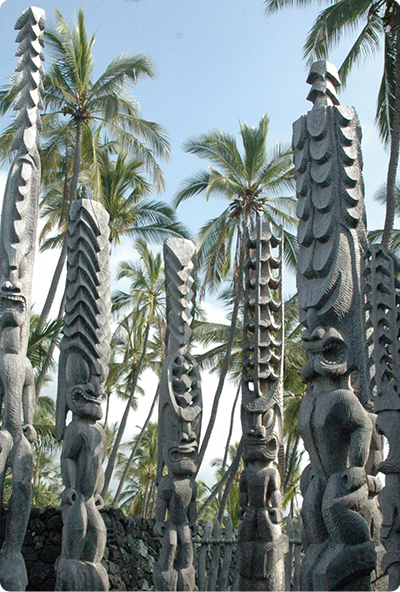
Reconstructed idols at Pu‘uhonua o Hōnaunau place of refuge, Kona, Big Island of Hawai‘i. Photograph © Clive Ruggles
Moderated by Stephanie Slater (CAPER)
Contributions:
- Astronomy of the Torres Strait Islanders Duane Hamacher (Australia)
- D(L)akota constellation of To/Tun Win (Blue/Birth Woman) Annette Lee (Dakota)
- Athabascan stellar astronomy: a novel and undocumented way of conceptualizing the sky Chris Cannon (Alaska)
- Indigenous star lore of Japan — myths, legends and Shinto shrines Akira Goto (Japan)
- Astral legends in China David Pankenier (Hawai‘i)
Session 2: Developing mutually acceptable methodologies
Moderated by Alejandro López (Argentina)
Contributions:
- East is not a Big Bird - improving collaboration between linguists and astronomers Gary Holton (Alaska)
- Kukaniloko Martha Noyes (Hawai‘i)
- Rapanui archaeoastronomy Juan Belmonte (Spain)
- Interpreting temples in Kahikinui, Maui Clive Ruggles (UK)
Session 3: Wayfinding
Moderated by John Mahelona (Hawai‘i)
Contributions:
- Practical uses of constellations for navigation etc in Japan Akira Goto (Japan)
- Rubellite Johnson (Hawai‘i)
- Instruction Kalepa Babayan (Hawai‘i)
Session 4: Preserving and perpetuating places and knowledge
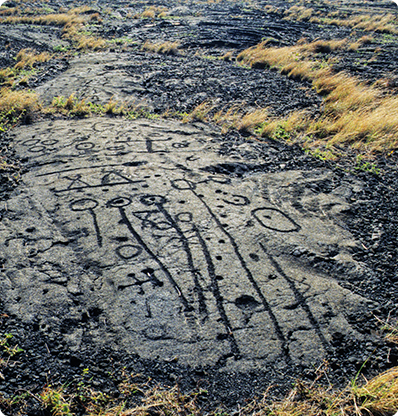
Petroglyphs at Pu‘uloa, Ka‘ū, Big Island of Hawai‘i. Photograph © Clive Ruggles
Moderated by Clive Ruggles (UK)
Contributions:
- Identity formation Richard Gelderman (USA)
- Knowledge as intangible heritage versus places as heritage sites Michel Cotte (ICOMOS)
- Safeguarding intangible heritage Gail Higginbottom (Australia)
- Honoring the feminine in Indigenous Star Knowledge Annette Lee (Dakota)
Participants attended from Hawai‘i, Alaska, Canada, the contiguous USA, Argentina, Chile, New Zealand, Australia, Japan and China as well as from the Canary Islands, France, and the UK. They included indigenous participants, cultural astronomers, astronomers, anthropologists, linguists and heritage professionals.
Outcomes

Two lava pillars used to mark the changing position of sunrise, Cape Kumukahi, Puna, Big Island of Hawai‘i. Photograph © Clive Ruggles
As a result of this meeting, several collaborations were formed, based upon shared concerns and mutual respect, that we hope will extend well into the future.
The meeting identified a number of areas of mutual concern between different groups represented at the meeting. For example, the protection of dark skies is a crucial issue both for modern astronomers and for those wishing to preserve ancient cultural sites relating to navigation and astronomy.
There was a reasoned and respectful debate concerning the current controversy over the siting of the Thirty-metre Telescope (TMT) on Mauna Kea, despite a wide range of views being expressed. The meeting was, however, unanimous in viewing with grave concern the proposal to install a large number of wind turbines across the district of Kahikinui, Maui, given the prospect of wide access roads breaking up what is perhaps the largest and best preserved contiguous cultural landscape surviving in the Hawaiian Islands from pre-contact times.
The meeting considered ways in which a heritage approach could help to raise awareness of and respect for, and thus help to preserve, both places and cultural traditions. In particular, Michel Cotte drew attention to the possibilities offered by UNESCO’s Convention for the Safeguarding of Intangible Cultural Heritage for serial international nominations that could relate to key themes such as ocean navigation.
Principal Organisers
This meeting was jointly conceived by Clive Ruggles, President of the IAU’s new Commission on World Heritage and Astronomy and past president of the International Society for Archaeoastronomy and Astronomy in Culture, ‘Āhia Dye (Hawai‘i), Program specialist at the ‘Imiloa Center, Hilo, and Stephanie Slater (USA), Director of the Center for Astronomy and Physics Education Research (CAPER).
Local organisation was co-ordinated by Stephanie Slater (CAPER), Sharon Schleigh (CAPER) and Lehua Veincent (Kamehameha Schools).
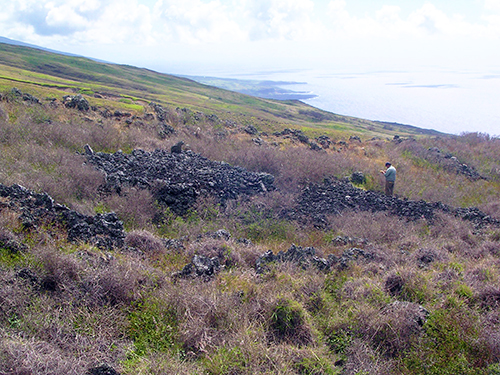
Temple NAK–30 and other structures viewed from the NW, Kahikinui district, Maui. Photograph © Clive Ruggles
The meeting viewed with grave concern the proposal to install a large number of wind turbines across the district of Kahikinui, Maui, given the prospect of wide access roads breaking up what is perhaps the largest and best preserved contiguous cultural landscape surviving in the Hawaiian Islands from pre-contact times.